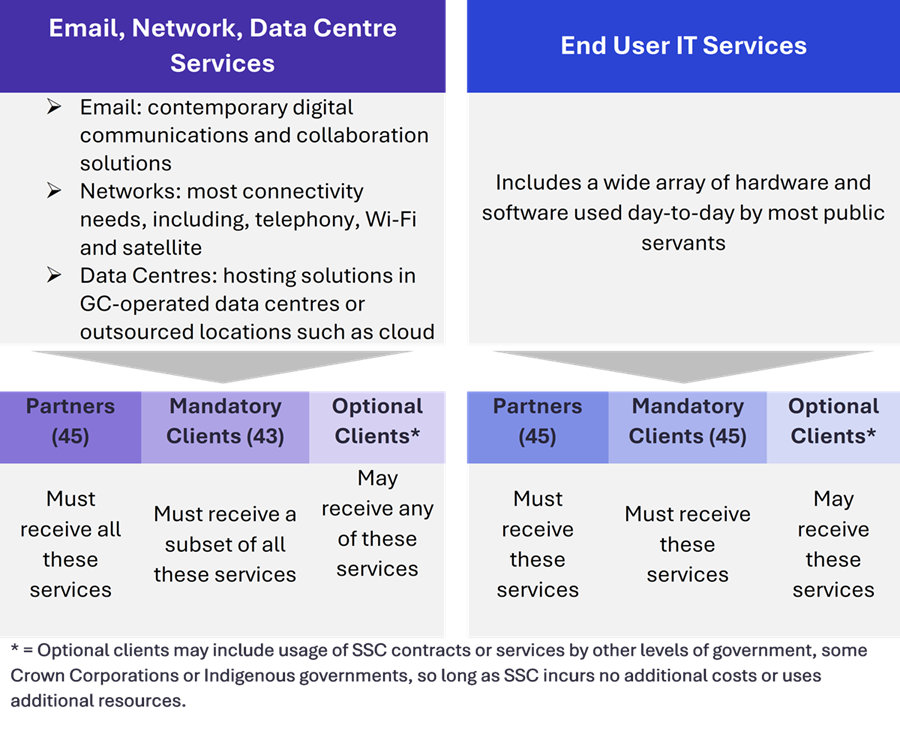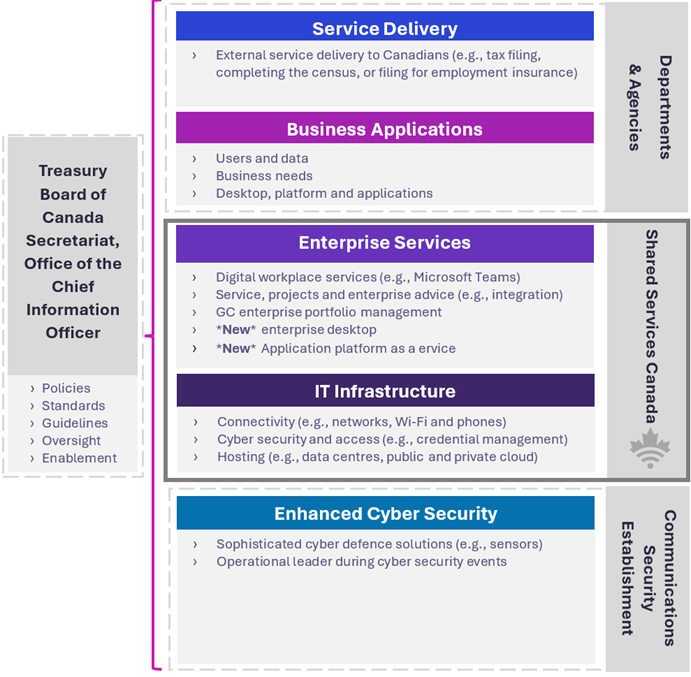Shared Services Canada Minister’s Transition Binder – March 2025
On this page
Welcome letter
Dear Minister,
On behalf of our entire team, we would like to take this opportunity to welcome you and congratulate you on your recent appointment as the Minister responsible for Shared Services Canada (SSC). We look forward to working with you to implement the government's agenda.
While SSC is not widely known, we are one of the single largest consumers of information technology goods and services in the North American market, and we work collaboratively with industry partners to deliver our services.
SSC is mandated to drive the Government of Canada (GC) into the digital age. In the past the SSC mandate was focused on consolidating and modernizing infrastructure, and while that work is ongoing, SSC is now also delivering the foundational services necessary for the GC to recover its position globally as a leader in digital government.
SSC is essential to the operations of government. We are present wherever the GC operates — spanning nearly 4,000 locations across Canada and around the world, with dedicated teams that work around the clock, 24 hours a day, 7 days a week. Our work is guided by One SSC to Deliver Digital Together, which centers on the evolution to a fully integrated, client-centric organization. One SSC focuses on providing connectivity, cybersecurity, hosting, and digital services to enable public servants across Canada and around the world to deliver federal programs and services to Canadians.
While IT infrastructure and cyber evolution and resilience remain core priorities for SSC, the department’s other key priorities include:
- delivering on the GC’s ambitious Application Hosting Strategy to provide secure, reliable and cost-efficient options for critical business applications;
- providing modern, enterprise-wide business applications;
- prototyping an enterprise approach to all end-user technology; and
- building artificial intelligence (AI) tools for the GC that are secure, cutting edge and that protect the data Canadians entrust to government.
Since our creation as a department, SSC has increased the reliability of government technology and decreased associated costs, all while consumption of our services has skyrocketed. Our work has provided the GC with one of the most sophisticated cyber defences in the world, which we deliver alongside our colleagues in the Canadian Centre for Cyber Security. However, it is SSC’s best-in-class commercial cyber defences that have blocked over 6 trillion malicious cyber activities. In summary Minister, while SSC’s model is providing tangible results, there remains significant room to do better.
At its inception, SSC was transferred a multitude of systems and networks from 42 partner departments. These were aging or completely outdated, lacked interoperability with modern infrastructure, and were, in short, a mess. Since its creation, the department has expended considerable effort to consolidate this infrastructure and invest in repairing and replacing critical platforms, as well as in standardizing a set of core enterprise services that we now provide to 45 partners and 93 client departments. By shifting the business model from a siloed, decentralized system to a new government-wide approach, SSC has reduced costs, boosted reliability and strengthened security. While this work continues, our single greatest risk remains the unhealthy applications within the GC, as noted by the Auditor General of Canada.
In 2023-2024, SSC procured $4.3 billion of goods and services on behalf of GC departments and agencies, including SSC itself. Through this, SSC leveraged our purchasing power to increase access to economic opportunities for Canadian businesses, small and medium sized enterprises and Indigenous-owned businesses. We are particularly proud to have exceeded the government target of 5 percent Indigenous procurement.
Looking ahead, SSC will continue to modernize costly and vulnerable legacy systems; advance reliable, secure and integrated enterprise services; and decrease vendor concentration through diversification efforts. We will also continue to implement cost saving measures aligned with the Refocusing Government Spending initiative. This includes reinvestment within SSC in several areas, including reviewing our existing services to eliminate duplication, and phasing out outdated and costly legacy applications across the GC to generate further savings, improve efficiency, and strengthen our cyber security posture.
We look forward to building a collaborative and productive relationship with you and your team. Our management team is available, at your convenience, to brief you on all departmental business.
Minister, we wish you all the best. Congratulations once again.
Sincerely,
Scott Jones
President, Shared Services Canada
Raj Thuppal
Executive Vice-President, Shared Services Canada
Departmental overview
Shared Services Canada (SSC) was created in 2011 as the common digital service provider for the Government of Canada (GC). Its mandate is to consolidate, modernize and secure the information technology (IT) infrastructure that supports departments and agencies – enabling service delivery to Canadians, and implementing GC priorities at home and abroad. Moving from an outdated and decentralized approach to GC IT to an SSC enterprise approach has created value through economies of scale and resulted in secure, reliable and cost effective service delivery for Canadians.
SSC provides essential IT services to departments and agencies, including email, networks, data centres, and end-user support (like hardware and software digital services).
SSC is wherever the GC is ― spanning nearly 4,000 locations across Canada and around the world. We have dedicated teams who work around the clock – 24 hours a day, 7 days a week, 365 days a year. While we do support traditional office work, we also enable our partners in frontline service delivery, national security, and defence operations. SSC services support GC call centre agents, scientists, park rangers, food inspectors, lighthouse keepers, border guards, and our Canadians in uniform. We proudly support over 200,000 federal employees and over 145 federal organizations.
SSC has four primary service categories: Hosting, Connectivity, Digital Services, and Cyber Security.

Hosting
SSC is working to create a reliable, sustainable, and cost-effective hosting ecosystem that meets the needs of partner departments and agencies. SSC will achieve this goal through an hybrid hosting model, which combines cloud services and traditional data centres to optimize performance, reduce costs and provide flexible solutions to respond to partners’ evolving needs. SSC is advancing the hybrid model through several key areas, ensuring the GC has modern, secure and efficient digital infrastructure:

- Cloud Services – Providing secure, scalable, and flexible cloud solutions, including public, private and hybrid cloud, to enable departments to rapidly deploy and manage digital services while optimizing costs.
- Data Centre Services – Delivering reliable and resilient enterprise data centre hosting at four Canadian sites that consolidate and modernize government IT infrastructure, ensuring high availability, efficiency, and security.
- Core Platform, Application, Data, and Software Services – Providing the essential IT environments for government applications and data. This includes managing operating systems, databases, platforms, and storage to ensure secure, reliable, and efficient digital services for departments.
- Enterprise Applications – Supporting government-wide digital transformation by providing and managing shared applications that improve collaboration, streamline operations, and enhance service delivery to Canadians.
Reducing legacy and aging IT
The continued use of outdated or obsolete legacy systems represents a significant risk as they are more likely to fail, more costly to maintain, and more vulnerable to security breaches—at a time when bad actors in cyberspace are increasingly aggressive and sophisticated. SSC has worked with partners to move many critical applications off unstable aging infrastructure and has decommissioned over 500 of the GC’s 720 legacy data centres.
SSC is standardizing and modernizing its hosting platforms, including operating systems, mainframes, storage and high-performance computing, to reduce complexity, improve manageability, and deliver consistent, high-quality services that meet the diverse needs of SSC's partners. These solutions enhance efficiency, improve security and reliability, and lead to significant cost savings by leveraging the latest technologies and economies of scale.
Offering flexible hybrid hosting options
To meet the diverse needs of partners, SSC is advancing a hybrid hosting model that combines secure cloud services with on-premise data centre solutions. This approach provides flexibility, scalability, and security while ensuring that applications and data are hosted in the most appropriate environments.
Enhancing service delivery
SSC is introducing automation and self-service tools to streamline processes, reduce wait times, and improve service reliability. These improvements enable departments to launch digital services more quickly, respond to issues faster and allocate resources to higher-value work.
Bolstering stewardship and predictability
Ensuring transparency and financial predictability in hosting services helps departments make informed decisions about IT investments. SSC is optimizing cloud and data centre costs, enhancing financial reporting, and improving forecasting to support sustainable IT spending.
By strengthening financial oversight and governance, SSC is creating a more accountable, cost-effective hosting environment that aligns with the government’s long-term digital strategy.
Conclusion
SSC’s strategic approach to modernizing hosting services is ensuring that government IT infrastructure is secure, efficient, and future-ready. By addressing legacy systems, standardizing solutions, providing flexible hosting options, enhancing service delivery, and improving financial stewardship, SSC is supporting the GC’s broader digital transformation while delivering high-quality, reliable services for all Canadians.

Connectivity

SSC delivers modern connectivity services—network infrastructure, telecommunications and teleconferencing—for the federal government.
In recent years, SSC accelerated bandwidth improvements, upgraded network performance and significantly increased secure remote access capacity. SSC has increased the overall bandwidth available by a factor of 10 and reduced the cost of access by approximately half to meet a surge in demand and ensure smoother, more reliable communication.
As of February 2025, SSC has deployed Wi-Fi in over 1400 GC sites. Instead of installing Wi-Fi only on the floors occupied by a requesting partner, SSC has introduced a whole-of-building approach to installing enterprise Wi-Fi, to quickly scale up, and generate a cost avoidance of roughly 66%. These efforts enhanced productivity and reduced the number of critical network service incidents.
To provide high-speed connections in remote locations, SSC awarded contracts for Low Earth Orbit (LEO) satellite services, on an as-and-when-required basis.
SSC established GC network hubs across the country in Toronto, Montreal, Vancouver and a distributed hub in the National Capital Region. The hubs provide the external network connectivity between the GC network, the Internet and the cloud. Adding local hubs speeds up the network for users in the region and improves service availability, as it serves as an additional location to route network traffic should another hub experience a service disruption.

Digital Services

SSC provides GC workers a common digital experience with a standardized bundle of tools anywhere, anytime, from any GC device.
SSC has migrated 37 of 45 partner departments from isolated email systems to a unified suite of collaboration tools hosted on a cloud-based platform, improving information sharing and security across the government. This enterprise cloud email service is available 99.9% of the time, a considerable improvement from the fragmented legacy systems it replaced. As part of this work, SSC leveraged the GC’s buying power to negotiate a competitive enterprise service agreement with two vendors that locked-in rates over a lengthy term to centrally support all departments with M365.
SSC rolled out an enterprise conferencing and collaboration suite which enables a common, secure, and integrated workspace for all GC workers. This facilitates collaborative work between GC employees, regardless of their work location, increasing the methods of communication and improving worker productivity.
SSC delivers IT solutions for over 220 GC contact centres that manage citizen inquiries and requests on a wide range of programs like Employment Insurance and the Canada Dental Care Plan. As part of a multi-year initiative to improve service delivery to Canadians, SSC is modernizing contact centre services by migrating them from legacy infrastructure to modern solutions. Modernized contact centre solutions are more convenient, secure and reliable, and include the ability to communicate through voice, chat, email or videoconference. It is also improving the user experience with call-back and self-serve options.
SSC also oversees the secure and cost-effective, end-to-end management of 219,000 mobile devices for 45 partners and 5 client departments. SSC introduced an enterprise softphone service which is significantly reducing the reliance on outdated fixed telephony lines and mobile devices. Through SSC's bulk purchasing of smartphones, preferred rates have been secured, resulting in $20M in annual savings for the GC.

Cyber Security
SSC provides the infrastructure and modern commercial defences that take over 6.6 trillion actions per year to defend the GC from a wide range of cyber attacks. The Canadian Centre for Cyber Security (CCCS), part of the Communications Security Establishment (CSE), layers on defensive capabilities that are not currently available commercially. Together SSC and CSE provide the most sophisticated layers of cyber defence available to any entity.
Further, by standardizing and consolidating IT across the GC, SSC is actively reducing the number of potential threats that could exploit system vulnerabilities.
A shared responsibility between SSC, CSE, the Treasury Board Secretariat (TBS), and partner organizations, teams act jointly to find the root causes of cyber incidents, reduce their impact, and support recovery efforts. SSC’s responsibilities include:
- Cyber Resilience: Building strong and secure systems, like reliable cloud services and government networks. SSC uses security measures such as firewalls, network scans, anti-virus, anti-malware, identification and authentication tools and services.
- Digital Trust: Protecting identities and managing access to information across the government, including digital credentials. SSC applies the zero trust framework, which replaces the dated idea of security based on physical location with authentication of every request and restricting users’ access to only what they need to see.
SSC and CSE’s technologies are complementary. SSC ensures the GC is protected by state-of-the-art commercial solutions while CSE fills the gap between commercial solutions and the most sophisticated adversaries.
In 2022, the National Security and Intelligence Committee of Parliamentarians found that small departments and agencies (SDAs) outside SSC’s Enterprise Internet Service were more exposed to security threats. To close the gap, SSC is currently working with 43 SDAs to offer IT services, namely enterprise internet, email, remote access, local internet service and software to detect malicious activity. At the end of 2023-24, 15 SDAs had been fully onboarded to Internet and remote access connectivity service solutions and 8 had migrated to the enterprise email solution.
Key facts
Organizational snapshot
- 400,000 user accounts and over 145 organizations across the federal government are supported by SSC.
- Nearly 4000 locations from coast to coast to coast and around the world have operations and service delivery supported by SSC.
- From traditional office work to scientists in labs, front line service delivery and national security, policing and defence operations.
Finances
- SSC authorities used in 2023-24:
- Net expenditures: $2,790.8 million
- Gross operating expenditures: $3,358.3 million
- Gross capital expenditures: $332.9 million
- Revenues netted against expenditures: $900.4 million
Employees
- 9,276 employees as of 2023-24
- 31% in the regions (outside the National Capital Region)
- Demographics:
- 35% women (3% below workforce availability)
- 22% visible minorities (4% above workforce availability)
- 7% persons with disabilities (2.5% below workforce availability)
- 3% Indigenous Peoples (1% above workforce availability)
- Official languages:
- 60% bilingual
- 39% unilingual English
- 1% unilingual French
Locations
SSC has employees, offices and data centres across the country:

Where SSC came from
SSC was established to standardize and consolidate certain administrative services supporting government institutions for the purpose of enabling the effective and cost-efficient provisioning of information technology (IT) services.
- 2011
- SSC is created to consolidate and modernize the GC IT Infrastructure
- 2015
- Order-in-Council 2015-1071 consolidates and implements previous mandate expansions
- 2019
- SSC 3.0 is launched, providing strategic direction for an enterprise delivery model
- 2020
- SSC supports the GC in COVID-19 response efforts. The Policy on Service and Digital takes effect
- 2021
- The GC Digital Standards: Playbook is published
- 2022
- Canada’s Digital Ambition 2022 is released
- 2023
- SSC continues to evolve GC IT services with Digital Together
- 2024
- Launch of One SSC to work as an integrated customer-service organization
Digital Together and One SSC
In 2023, SSC set out Delivering Digital Solutions Together for Canada, a strategic approach to ensure that government departments are equipped with the modern, standardized tools. To deliver that vision, in 2024 its leadership set out a goal to become One SSC: instead of behaving as a collection of branches, to transform SSC into an organization that works together, shares a common goal and speaks with one voice to partners and clients.
Categories of services and clients
SSC is responsible for providing shared IT services related to email, networks, data centres, and end user IT, such as computers and printers. Order in Council 2015-1071 outlines four broad categories of services that SSC must, or may, provide to its clientele.

Long description
A graphic depicting SSC's partners and clients:
1. Email, network, and data centre services have 45 partners, 43 mandatory clients and some optional clients
2. End user IT services has 45 partners, 45 mandatory clients and some optional clients
Where SSC is placed in the Government of Canada (GC) IT ecosystem
The government digital landscape is complex – and SSC plays a critical role as the GC’s common IT service provider.

Long description
A graphic depicting the government's shared role in the IT ecosystem:
1. Departments and agencies themselves are responsible for service delivery and business applications
2. Shared Services Canada is responsible for enterprise services and IT infrastructure, like connectivity, cyber security and access, and hosting
3. The Communications Security Establishment is responsible for enhanced cyber security
4. The Treasury Board Secretariat and Office of the Chief Information Office are responsible for policies, standards, guidelines, oversight and enablement
Issue notes
In this section
Government of Canada Priority Programs and Projects
Issue
Shared Services Canada (SSC) works with the Treasury Board of Canada Secretariat (TBS) Office of the Chief Information Officer (OCIO) and partner departments and agencies to advance Government of Canada (GC) priorities for the digital delivery of programs and services to Canadians. SSC collaborates with partners on information technology (IT) solution design, project planning, architecture and data migrations, and offers project management services as required.
SSC’s role in these programs or projects varies – from enhancing network infrastructure or supporting modernized partner applications, to procuring enterprise services for cloud or managing digital credentials. Projects are aligned with the GC Digital Ambition, working towards the delivery of secure digital services.
The modernization of the GC IT ecosystem is critical as the current health of the environment is exposing the government to unacceptable levels of risk. A strategic approach to managing this risk is required to align investments by SSC and partner departments and agencies, as the Auditor General highlighted in her 2023 report on Modernizing Information Technology Systems.
If partner departments and agencies do not plan for and invest in modernizing their business applications, SSC is unable to refresh backend infrastructure and hosting services – a situation that introduces important systemic risk to the GC. This risk is manifested in two ways. First is the risk of system outages; second is the risk of the GC being unable to implement new policy directions because government systems are so outdated and complex that even minor changes can introduce instability.
Projects and initiatives
The following list includes some active priority projects where SSC plays a role, and where the Minister may have some level of engagement with colleagues:
-

Employment and Social Development Canada (ESDC) ten-year initiative to modernize benefit delivery services for Employment Insurance (EI), Old Age Security (OAS) and the Canada Pension Plan (CPP)
By 2030, the new Benefits Delivery Modernization (BDM) solution will provide an easy-to-use, integrated, adaptable and secure cloud-based platform. SSC is actively supporting the GC digital agenda to modernize citizen services, enabling secure, easy one stop sign-in access and modernized contact centre support. In this context, SSC is providing the connectivity services that underlay BDM, as well as undertaking procurement of technology solutions. The project achieved the first live OAS onboarding in June, 2023, and plans for the final onboarding of OAS in March 2025. SSC, with ESDC, is also planning future EI onboarding. SSC is working with partners to establish new procurement vehicles by 2025. These will enable GC cloud infrastructure services, customer identity and access management as well as contact centres. These procurements build on lessons learned and achieve cost efficiency.
-
Canada Border Service Agency (CBSA) – Assessment and Revenue Management Project (CARM)
The CARM digital initiative, that spanned 7 years, is changing how CBSA assesses and collects duties and taxes on commercial goods imported into Canada. The initiative provides digital services to partners (customs bonded warehouse licensees, importers, customs brokers, trade consultants, financial security providers and other trade chain partners) to enable them with a modern, secure, consolidated and user-centric solution. In October, 2024 the CBSA successfully launched Release 3 of the CARM solution, which is now the official system that importers and other trade chain partners are using to assess and pay duties and taxes on imported goods. Now that CARM Release 3 is live, the project will continue to focus on ensuring that the system functions as designed through a period of heightened care over the coming months. This will permit the implementation of any required fixes and improvements to ensure a stable environment and to enhance the user experience.
-

Canada’s 2025 G7 Presidency (G7)
Canada assumed the presidency of the G7 as of January 1, 2025, and will host the G7 Summit and a series of related events, such as ministerial and sherpa meetings. The summit will be held in Kananaskis, Alberta, from June 15 to 17, 2025, with a footprint extending from Calgary to Banff. Global Affairs Canada (GAC) is the lead department responsible for delivery of the G7 Summit, and there are approximately 13 federal agencies involved in the delivery of the Summit, with SSC responsible for providing comprehensive infrastructure and telecommunications services to all stakeholders. Construction work is underway for both the core network and the cellular infrastructure upgrades, which are being slated for completion by April 2025. Venue work and circuit provisioning will be completed in May 2025.
-
Immigration, Refugees and Citizenship Canada (IRCC) – Digital Platform Modernization
The development of Canada’s new “digital first” integrated migration system to replace the aging Global Case Management System (GCMS) is critical to IRCC’s ability to manage immigration. GCMS is among the most problematic GC systems from a service management perspective, with service outages having broad impacts on a range of services that impact those entering and departing Canada. Tremendous effort is required to simply maintain GCMS. While SSC is being proactive about modernizing the existing system to improve stability, its age and complexity is a limiting factor. Over the long-term, this project will strive to deliver an adaptable and reliable system that will enable a seamless, end-to-end experience, support clients and employees, ensure equitable outcomes, and keep up with the latest advancements in technology. SSC is supporting the cloud and on-premises elements of the solution and the eventual migration from and decommissioning of GCMS.
Hosting Services
Issue

Hosting is the service that provides the necessary facilities, information technology (IT) infrastructure, software, security, management, and support to run and manage the Government of Canada's (GC) applications and data. The GC depends on hosting services to support its digital infrastructure, which is crucial for delivering services to Canadians, ensuring data security, and maintaining efficient operations. Hosting services are offered through data centres, cloud hosting, and hybrid solutions that meet the diverse needs of different departments:
Enterprise data centres (EDC): Shared Services Canada (SSC) operates several EDCs located in Canada. These are modern facilities with IT infrastructure and the underlying applications, software, and data that ensure secure and reliable hosting for the GC's applications and services.
Cloud hosting: The government is increasingly adopting cloud services for flexibility and scalability. SSC or trusted Cloud Service Providers (CSP) can offer cloud services that provide on-demand availability of IT infrastructure, applications, software, and data storage over the Internet so the user does not have to manage them. While the transition to the cloud can improve service delivery, SSC is mindful that strong governance is required to ensure expenses do not escalate quickly.
Hybrid solutions: By combining cloud services with traditional data centres, the government can deliver cost-effective services that meet the diverse needs of its partners. This approach allows for optimized use of the cloud and the conventional data centre approach, ensuring efficient and tailored solutions.
Background
The government’s hosting strategy has evolved since SSC was established in 2011 to modernize and consolidate GC IT services. In 2013, SSC began consolidating hosting infrastructure by modernizing and moving legacy systems to modern EDCs.
In 2016, the GC introduced a Cloud Adoption Strategy to encourage cloud services alongside data centres. In 2018 this shifted to a "cloud first" policy that prioritized the cloud for new applications. In the intervening years, the government recognized the need to address the costs associated with this shift and to implement greater rigour through a whole-of-government approach.
In 2024, the government shared its GC Application Hosting Strategy to ensure a sustainable hosting ecosystem that delivers high-quality digital services while optimizing costs and reducing risks. The Strategy focuses on four key areas:
- Governance and oversight: Establish strong governance to manage performance and costs
- Competitive procurement: Use effective procurement processes to support long-term operations
- Sustainable funding: Implement predictable and transparent funding models
- Cohesive and consolidated Application Hosting Services: Consolidate hosting services to reduce burdens on federal institutions
While full implementation of the Strategy will take time, SSC has started work to operationalize more integrated hosting services for our partners.
Reducing legacy and aging IT
Aging IT systems must be decommissioned to support reliable service delivery. By retiring outdated infrastructure, SSC reduces risks, costs, and security vulnerabilities. These moves address the concerns in the Auditor General's 2023 Report on Modernizing IT Systems. Key initiatives include closing legacy data centres and migrating workloads to modern EDCs or cloud solutions. SSC has closed 501 legacy data centres of the original 720 facilities planned for migrations to our four modern EDCs.
Considerations
Rising costs
The costs associated with IT infrastructure and software licenses continue to increase. Given the large scale of SSC's operations, even small cost increases can significantly impact the overall budget. Managing these rising expenses is crucial to maintaining financial stability and ensuring the sustainability of SSC's services.
Reliance on vendors (vendor lock-in)
Relying heavily on a single provider can lead to vendor lock-in, limiting flexibility and increasing dependency on the provider's ecosystem and pricing, which makes it challenging to negotiate better terms or switch solutions. Migrating to other platforms is also technically demanding and resource-intensive, further complicating efforts to maintain flexibility and control costs.
Dependencies on partners
The GC’s Application Hosting Strategy requires significant changes in partner departments' operations, including shifting resources to SSC. This whole-of-government approach depends on strong collaboration and alignment; any delays or resistance could hinder the Strategy's success.
Digital sovereignty
Digital sovereignty is a country's control over its technology, infrastructure, and data to protect its interests. It requires that data is governed by local laws, ensuring compliance and safeguarding sensitive information. SSC’s EDCs in Canada help protect Canadian data.
Next steps
SSC is standardizing and modernizing its hosting platforms, including operating systems, mainframes, storage, and high-performance computing, to reduce complexity, improve manageability, and deliver consistent, high-quality services that meet the diverse needs of SSC's partners.
Connectivity Services
Issue
Shared Services Canada (SSC) maintains the network and connectivity of the Government of Canada (GC) ensuring public servants can connect anywhere, anytime, across Canada and at international locations.
Background
Years ago, SSC began to modernize network services for the GC, moving towards a whole-of-government enterprise solution, which replaced network services tailored to each individual department and agency. This streamlined approach reduced operational costs while improving network speed and consistency, remote connectivity and security.
Bandwidth – improving availability
At any given moment, a user’s access to GC networks must be secure. At the same time, those networks must have the ability to manage quick and large fluctuations in the demand on bandwidth. At its creation in 2011, SSC inherited complex and aging network infrastructure from multiple organizations. This infrastructure was costly to maintain and did not support the modern cloud, video and voice services used by public servants to deliver services to Canadians across the country.
Since then, SSC has consolidated and modernized network IT infrastructure through standardized technology and contracts, and simplified administration. Designing the network to be appropriately secured from the ground up minimizes flaws that could compromise security. Consolidating and standardizing to a common, shared, enterprise network improves reliability and stability, and reduces the time and effort spent on maintenance and troubleshooting.
SSC increased the overall bandwidth available by a factor of 10 and reduced the cost of access by half. SSC’s new approach leverages software-defined network infrastructure and artificial intelligence (AI) to automate traffic flow and maintenance. This is done in four GC Networks Hubs across Canada. SSC has installed hubs in Toronto, Montreal and Vancouver, and is evolving the distributed hub in the National Capital Region (NCR) by adding capabilities and moving it from its current legacy locations into modern facilities. There will likely be other hubs in the Prairies and the Maritimes in the future. This is key to how we manage connectivity and security from the GC network to external networks (the Internet and public cloud).
SSC has shifted to a “whole-of-building approach” when providing Wi-Fi services. This includes installing Enterprise Wi-Fi to a whole building, rather than just the floors occupied by a requesting partner. This approach not only significantly reduces costs (cost avoidance of roughly 66%), it is more environmentally sustainable by decreasing consumption of copper and precious metals, such as gold and platinum.
Increased presence in the office

In 2023, the public service adopted a common hybrid work model that saw employees returning to GC work sites. SSC supported the hybrid model by significantly increasing network capacity, addressing security demands and increasing functionality of workplace collaboration tools. SSC has made bandwidth upgrades at hundreds of GC sites, and linked video conferencing to thousands of government boardrooms across the country.
In 2024, SSC once again ramped up this work to support departments to comply with the updated increased presence in the workplace (i.e., a minimum of three days a week for public servants and four days for executives). An additional 250 sites were identified for bandwidth upgrades, which are mostly located in regions outside of the NCR. Of those, 34 sites have been upgraded so far and more are being done as partners identify sites that need upgrades.
As of February 2025, SSC has deployed Wi-Fi in over 1,450 buildings. Over 1,250 videoconferencing systems have been modernized over the past year. By providing Wi-Fi and videoconferencing services, SSC supports the work of employees in workplaces across the country and around the world.
Connectivity in remote areas

SSC awarded contracts for Low Earth Orbit (LEO) satellite services to provide high speed internet connections in remote locations for GC organizations. These services are on an as-and-when-required basis, so the GC only pays for services when they are needed.
LEO satellites operate at a much lower altitude than geostationary satellites and provide encrypted connectivity for vehicles on land and at sea, or for buildings in areas with no traditional coverage from terrestrial or cellular providers. For example, the Royal Canadian Mounted Police and the Department of National Defence (DND) are using the service in Iqaluit and at Canadian Forces Station Alert to provide connectivity to their departmental networks.
SSC currently has LEO satellite services contracts with two providers, and intends to diversify solutions with new providers as they come online.
Providers are selected by SSC based on business requirements set out by departments and agencies.
Considerations
Key ongoing considerations for connectivity modernization include factors that are both predictable and unpredictable, such as:
- Technology infrastructure and tools continuing to evolve at a rapid pace
- Increased frequency and sophistication of cybersecurity attacks, as well as adoption of new technologies
- Continued sudden increases in bandwidth requirements (both planned and unplanned)
- Ongoing reliance of some partner departments and agencies on legacy and aging infrastructure
Next steps
SSC plans to improve its GC Network Hubs by integrating the science network connectivity (CANARIE) into the hubs and establishing more domestic and international hubs where appropriate.
SSC plans to continue to leverage and improve the connectivity and security posture of the Canada-United States Network to support DND and the Canadian Armed Forces’ partnership with the United States Department of Defense.
In terms of procurement, SSC is working on new contracting vehicles to make larger amounts of bandwidth available to meet our partners’ increasing needs.
Digital Services
Issue
Shared Services Canada (SSC) aims to deliver an efficient, consistent experience with a standardized core suite of tools—available anytime, anywhere, on any government device—improving productivity, efficiency, mobility and collaboration between Government of Canada (GC) employees across the enterprise.
Background
Historically, end-user services were managed independently within departments, which led to inefficiencies, duplication of effort and inconsistent user experiences. This approach increased operational cost, limited scalability and innovation, and constrained worker mobility. Adopting a more centralized strategy to equip employees with modern tools reduces costs, improves operational efficiency and enhances security.
When SSC was created in 2011, it inherited a multitude of bespoke services in various states of repair. Following multiple modernization and consolidation initiatives over the years, SSC’s vision for Digital Services advances a standardized, enterprise-wide approach to deliver secure and accessible digital tools. SSC’s Enterprise Service Model provides centralized, and standardized tools across government to ensure consistency, efficiency, reduced costs and scalability in government services.
A key proof of concept for this model is the Enterprise Mobile Device Management (EMDM) service. Through EMDM, SSC manages over 219,000 smartphones across more than 50 organizations, ensuring secure, always-available access to communication and collaboration tools. This centrally managed service offers:
- Cost efficiency – Bulk procurement and centralized management reduce cost
- Consistent security – Common controls ensure compliance
- Mobility – Users retain their devices and phone numbers when transferring between departments, ensuring seamless transitions and a consistent user experience while reducing electronic waste
The success of EMDM prompted SSC to extend the Enterprise Service Model to other critical services, including email, conferencing and softphones. There are additional opportunities to expand this model to desktop services and directory, which connects computers and users through domain-based services.
Considerations
Enterprise desktop services
SSC is currently implementing a project to develop an Enterprise Desktop Service model (EDS) which will encompass standardized desktop engineering, IT asset management and support services that could be leveraged by all departments. Notably, desktops are currently managed by each partner department independently of SSC. An enterprise service is expected to reduce support costs, enhance security, and increase productivity for GC workers. Digital tools will be tailored to GC worker personas, not their departments’ preferences, which will enable greater scalability and reduced cost through unified end-to-end support, asset management and agile procurement processes. Workers will retain their devices longer and the GC will achieve cost savings through the economies of scale of centralizing the end-to-end management and delivery of the service.
Communications and collaboration
SSC is modernizing email and office applications, like word processors and spreadsheet software, to a consolidated cloud-based solution. The M365 platform is used to give public servants modern collaboration tools that work efficiently in a hybrid environment. M365 includes a full suite of workplace applications, including Teams, Outlook, SharePoint and OneDrive.
Email migration to M365: 37 departments and agencies complete, 8 partner departments remain as of March 2025
Contact centre services
SSC Contact Centre Services procures, delivers and maintains over 200 contact centre solutions on behalf of GC organizations. These solutions for citizen interactions are scalable and flexible, and enable service evolution, business transformation and the adoption of emerging technologies. These modern tools include the ability to communicate through voice, chat, email or videoconference, as well as call-back and self-serve options.
SSC-supported call centres include Employment Insurance, Canada Pension Plan and Canada Revenue Agency, as well as smaller centres such as Non-Insured Health Benefits for Indigenous Services Canada and Marine Safety and Security for Transport Canada.
Call centre contracts: 2 current, 4 are an update-in-progress as of March 2025
Conferencing and collaboration space modernization
To support the hybrid work model, SSC is modernizing its conferencing services by delivering fully integrated services that support videoconferencing and collaboration in boardrooms.
SSC is upgrading or replacing devices to meet new accessibility and reliability standards. A new Meeting Space Services approach will standardize conferencing technologies for small, medium and large boardrooms across government, streamlining procurement and deployment through SSC, ensuring best value, while providing a consistent user experience.
Videoconferencing systems modernized: 2,479 meeting rooms are complete, 2,000 meeting rooms are planned as of March 2025
Enterprise mobile device management (EMDM)
Through the EMDM service, SSC ensures that employees can securely access GC networks and data using mobile devices and tablets, providing them with modern work capabilities anytime, anywhere. The initiative manages approximately 219,000 handheld devices (iOS and Android) across 45 partners and 6 client departments. SSC is focused on ensuring a high level of service availability, deploying new features, and expanding the service to include security and support requirements for classified services.
Partners and clients managed by EMDM: 45 partners and 6 clients are managed, 9 additional clients are planned as of March 2025
Softphones

SSC is adopting an enterprise approach to improve the delivery of telephony services and enable a mobile workforce. It is replacing outdated systems with modern solutions such as a softphone service that allows users to place and receive phone calls from their computer or phone over the Internet using M365. This service will provide unified communication services that can be accessed from any GC-issued device anywhere, anytime securely at a reduced cost.
Softphones: 46,000 are deployed, 75,000 are planned as of March 2025
Fixed phone line rationalization
Traditional and wired office desk phones are no longer useful for many employees and are costly to maintain. SSC has been working with partner departments to retire all non-essential lines, with a target to retain only 10% of fixed lines within the next 3 years.
Fixed lines disconnected: 155,000 are disconnected, 21,000 are in the disconnection process, 306,000 lines are to be reviewed as of March 2025
Next steps
Digital Services will provide access to a standardized core bundle of tools enabling work anywhere, at any time, from any GC-approved device. This approach will ensure cost-effective, secure, and accessible services and tools, expand self-service and automation capabilities, improve communication, mobility, and productivity, as well as enhance service agility and reduce time-to-market. A set of common administrative tools are required for the oversight and management of enterprise services. SSC will ensure that costs and outcomes are tracked in a consistent manner, including reporting on consumption of enterprise services that will inform data-based decision making.
The next step is to simplify the technology landscape, address technical debt and legacy solutions, and expand the delivery of secure, consistent and reliable services.
Cyber Security Services
Issue
Cyber threats to Canada are becoming more complex and sophisticated, threatening our national security and economic prosperity. This includes criminal activity such as ransomware attacks and state-sponsored adversaries.
Cyber security is a key dimension of the services provided by Shared Services Canada (SSC). Cyber security incidents impact services to the public and trust in institutions.
The Government of Canada (GC) works continuously to enhance cyber security in Canada by preventing attacks through robust security measures, identifying cyber threats and vulnerabilities, and by preparing for and responding to cyber incidents.
Background

SSC provides the infrastructure and modern commercial defences that take over 6.6 trillion actions per year to defend the GC from a wide range of cyber attacks. The Canadian Centre for Cyber Security (CCCS), part of the Communications Security Establishment (CSE), layers on defensive capabilities that are not currently available commercially. Together SSC and CSE provide the most sophisticated layers of cyber defence available to any entity.
Ultimately, cyber security in the GC is a shared responsibility. SSC, the Treasury Board of Canada Secretariat’s (TBS) Office of the Chief Information Officer (OCIO), and as mentioned, the CCCS within the CSE each hold key enabling roles.
TBS leads on a whole-of-government cyber security policy and provides strategic oversight of cyber security event management.
CSE is Canada’s technical and operational authority for cyber security. CSE and the CCCS provide leading-edge services to help prevent cyber incidents. This includes using sensors to detect malicious cyber activity at the host, cloud, and network levels and coordinates the reporting of cyber attacks.
SSC keeps GC systems secure with state-of-the-art enterprise infrastructure and security services. These include firewalls, network scans, anti-virus, anti-malware, identification and authentication tools and services.
SSC’s partner departments and agencies are responsible for the security and monitoring of the applications they use to deliver digital programs and services to Canadians.
Other stakeholders
Public Safety Canada leads the National Cyber Security Strategy, a whole-of-society strategy, working with stakeholders outside of the GC to protect Canadians and businesses from cyber threats.
The Royal Canadian Mounted Police are the primary investigative authority on all cyber security incidents dealing with actual or suspected cybercrime of non-state origin against GC infrastructure.
The Canadian Security Intelligence Service collects information and intelligence on activities suspected of constituting threats to the national security of Canada, and supports departments and agencies through security screening and foreign intelligence collection.
The Canadian Armed Forces collects and shares cyber threat intelligence with allies. In collaboration with CSE, the CAF conducts foreign cyber operations. It recently consolidated its capacities in the new Canadian Armed Forces Cyber Command (CAFCYBERCOM).
Cyber event management and planning
The Government of Canada’s Enterprise Cyber Security Strategy is a plan to improve cyber security across departments and agencies. It serves as a framework to move the government to a proactive cyber security approach by improving training, applications, policy and monitoring. The Strategy includes yearly risk management, talent development, third-party risk management and a new team to emulate techniques used by malicious threat actors.
Robust cyber event management processes are required to respond to cyber security attacks. The TBS-led Government of Canada Cyber Security Event Management Plan (GC CSEMP) sets an operational framework for the management of cyber security events that impact the GC’s ability to deliver services to Canadians. GC CSEMP outlines responsibilities across government for different levels of cyber events; with low-impact events being led by the responsible department and more serious events being led by teams coordinated by TBS and the CCCS.
SSC’s responsibilities during a cyber security event are internal GC-facing and include: watching for unusual network activity, blocking cyber threat activity, assessing service impacts, reporting through the Cyber Centre and implementing prevention, mitigation and recovery efforts, such as emergency patching and isolating infrastructure. While SSC’s role is internal GC-facing, the CCCS’s responsibilities are external-facing—their automated defences protect the GC from over 6 billion malicious actions a day.
During a cyber security event, the GC CSEMP response level determines the governance to direct and facilitate mitigation and recovery activities. The lead minister for the response is determined on a case-by-case basis, depending on the context of the event.
Considerations
By standardizing and consolidating IT across the GC, SSC is actively reducing the number of potential threats that could exploit system vulnerabilities. Alongside this work, SSC manages the ongoing GC IT landscape through a security lens. For example, SSC ensures that known vulnerabilities are addressed by updating software, drivers and firmware. SSC works in partnership with other departments and agencies to incorporate cyber best practices into operations, including the ongoing monitoring of critical systems within the GC.
SSC is shifting to a Zero Trust approach which is based on the idea that no person or device should be trusted by default, even if they are already inside an organization's network. This approach limits users’ access to information using a GC-managed device based on their security credentials.
Supply chain integrity
Since 2012, SSC has successfully completed over 80,000 supply chain integrity (SCI) procurement reviews to ensure that purchases of equipment, software or services are as safe from cyber security threats as possible.
SCI assessments allow a department to identify and potentially mitigate vulnerabilities to security. An assessment reviews the suppliers, subcontractors and equipment, including hardware, firmware and software, that will be used to create, store, process or transmit GC information. This information is assessed by the CCCS against three “pillars”:
- sensitivity (i.e., the context in which the equipment or applications will be used)
- ownership (including foreign control and influence)
- technical (i.e., whether there are known vulnerabilities or concerns relating to the hardware or software)
The assessment determines if there is a low, medium or high risk that products could be compromised. Bidders have opportunities to respond to concerns raised by the assessment, and mitigations can be required by the GC.
Next steps
The ever-evolving cyber threat environment has been advancing faster than ever. SSC will continue to strengthen the GC’s cyber security resilience by identifying critical gaps and opportunities, delivering new enterprise cyber security capabilities, and working to prepare for, respond to and recover from cyber attacks.
In addition to its core mandate to deliver IT services to its 45 partner departments, SSC also provides other departments and agencies with the option of using a package of SSC-managed networks, data centres, digital and security services.
SSC is currently working with 43 small departments and agencies (SDAs) to offer IT services, namely enterprise internet, email, remote access, local internet service and software to detect malicious activity. This helps SSC address an important gap raised by a 2022 National Security and Intelligence Committee of Parliamentarians Special Report, which found that SDAs outside SSC’s Enterprise Internet Service were more exposed to security threats.
Artificial Intelligence
Issue
Artificial Intelligence (AI) is considered to be a transformational technology, which stands to propel significant social and economic progress. Following the release of generative AI tools like ChatGPT, media and public interest in AI has grown. The government is increasingly looking to leverage AI to enhance the delivery of services to Canadians and optimize the work of public servants.
Background
Governments and organizations around the world are exploring AI’s potential to improve service standards, processes and reduce costs. Shared Services Canada (SSC) is using AI to make the work experience for SSC employees and other public servants more efficient and cost effective, while also protecting Canadians’ privacy and security.
What is AI?
AI is an umbrella concept that includes different processes and technologies.
Common terms in AI include generative AI, machine learning, natural language processing, computer vision and deep learning, as well as applications like robotic process automation (RPA) and intelligent automation (IA). Essentially:
- AI involves machines performing the tasks that typically require human intelligence, such as problem-solving, reasoning and language processing.
- RPA is an application that automates routine tasks to streamline workflows and make them more efficient.
- IA combines AI and RPA to enable machines to perform tasks that require human-like judgment and learning, while streamlining complex processes and improving their efficiency and accuracy.
Canada’s AI approach
The government is advancing the development of AI domestically and within its own operations.
The development and training of AI models requires substantial compute resources. Budget 2024 allocated funding to help Canadian researchers, start-ups and scale-up businesses develop AI infrastructure in Canada. The Budget also funded the creation of the AI Safety Institute, worker skill development, and a smaller secure computing facility to be led by SSC and National Research Council Canada for government and industry to perform research and development, including for national security purposes.
To assist departments in deploying automated decision-making systems responsibly, the Treasury Board of Canada Secretariat (TBS) released the Directive on Automated Decision-Making, the Guide on the use of generative artificial intelligence, and the Algorithmic Impact Assessment tool.
Furthermore, with participation of SSC and other departments, TBS has been leading the development of Canada’s first AI strategy for the public service, which will ensure that AI is deployed in a responsible, inclusive, and human-centric manner. The GC AI Strategy was published in March 2025.
Considerations
Global concerns surrounding AI development have emerged, particularly regarding governance and risk management including:
- legal, ethical and operational issues, including privacy and security
- substantial costs for computing resources and electricity
- limited regulatory oversight and governance
- fears of “lagging behind” that may lead to the hasty adoption of new technologies
- varied benefits across sectors of an organization
- rapid expansion in AI-integrated technologies
- the necessity of a GC standardized AI governance framework
- the imperative need to recognize AI's role and limitations
- use by cyber threat actors in sophisticated attacks, from malware to phishing
SSC has demonstrated its commitment to the responsible and ethical development of AI solutions by integrating the Algorithmic Impact Assessment into the departmental Project Management process releasing an SSC guide on the use of generative AI, and creating a use case assessment model to assess AI uses for value and feasibility.
Next steps
SSC has been exploring various scenarios where AI can bring business value to SSC and reduce the cost of running the department, as well as streamlining and improving the efficiency of the programs delivered by other departments and agencies. Across government, SSC is:
- Leading a GC AI Hub—A community driven, trusted first stop, a go-to for AI and Automation. The AI Hub is a living ecosystem that thrives on knowledge and experiences shared by the GC AI community, as well as promoting AI and automation use cases and experiences throughout the public service.
- Working closely with TBS in the creation and refinement of key policy documents, guidelines and best practices including the current GC AI Strategy for the Public Service frameworks.
- Leading and chairing government-wide AI and Intelligent Automation working groups and professional communities with a focus on AI innovation, AI literacy, knowledge-sharing, governance, and collaboration.
- Chairing a GC-wide AI Governance Forum focused on promoting development of AI in a responsible and ethical manner.
- Providing expert peer-review support to departments to ensure adherence to the TBS Directive on Automated Decision-Making and reinforcing the integrity of decision-making systems.
- Working toward expanding our role in AI, deepening our involvement to further support the needs of departments.
- Demonstrating the value of AI through thought leadership, expert advice, prototyping, and proofs of value.
Examples of AI use cases at SSC
- CANChat – This is a conversational chatbot tool developed by SSC that allows employees to enhance their productivity and unlock their creative potential with AI. Recognizing the importance of data security and privacy in government operations, CANChat was developed to provide an in-house alternative to commercial Generative AI tools such as ChatGPT. CANChat can help create emails and memos, edit documents, quickly summarize information, provide summaries on complex topics, as well as generate meeting agendas and talking points; all within a GC controlled environment that ensures appropriate security and data integrity are maintained. SSC is also developing the architecture and service controls to offer CANChat as an Enterprise Service to all departments.
-
SSC Assistant – This chatbot helps SSC employees find the information they need through a simple interactive conversation. Employees can research any unclassified topic related to their work, or retrieve the contact information of other employees. It sources information from corporate tools, SSC’s internal Intranet, and the Internet.

- Vote Netted Revenue: Financial Forecasting – This tool is trained on historical financial data to help forecast future revenue.
- Security Management and Government Turbo SA/A – This tool will optimize the already existing Security Assessment and Authorization (SA/A) review process, which ensures only authorized software and hardware is implemented at SSC. It will use AI to validate evidence against required security controls and identify anomalies.
- Robotic Process Automation of Access to Information and Privacy (ATIP) requests – This tool, originally developed by SSC, automatically eliminates duplicate records and indexes information to save time and ensure analysts stay focused on higher value work. This allows ATIP requesters to receive their responses faster. The code was shared with seven departments, and Transport Canada is now working on improving the tool.
Examples of GC AI use cases
- Public Services and Procurement Canada – in collaboration with SSC, PSPC automated portions of their MyPay Enquiry Process to optimize the pay inquiries process. This will help reduce the backlog and increase the productivity of a compensation advisor by at least 30 per cent.
- Canada Revenue Agency – Instead of waiting for a security code by mail, CRA now allows Canadians to gain access to their secure accounts right away using facial recognition technology, a smartphone and government-issued ID. More than 1 million taxpayers have already used the service.
- Employment and Social Development Canada – Machine learning is helping improve service delivery of the Employment Insurance (EI) program. Automation is reducing the manual intervention required every time an EI client provides new information or has a change in their circumstances. This is improving the accuracy of EI benefit calculations.
- Immigration, Refugees and Citizenship Canada – Advanced analytics and automation help streamline application processing for a better client experience.
- Transport Canada – Advanced analytics help identify and mitigate high-risk air cargo shipments before they are transported to Canada, enhancing security measures.
- Communications Security Establishment – AI assists in cyber defence by helping enable the detection of a variety of threats, including identifying previously unseen malware on government networks and quarantining it.
Procurement
Issue
As the single largest purchaser of goods and services in Canada, the federal government recognizes the important role it plays in supporting and growing Canadian businesses. The Government of Canada (GC) purchases about $37 billion in goods and services each year—Shared Services Canada (SSC) and Public Services and Procurement Canada (PSPC) handle more than 75% of the value of these purchases.
In 2023-24, SSC:
- awarded 12,320 contracts and amendments valued at approximately $4.3 billion
- awarded 5,742 contracts, valued at $2,370 million, that were competitive
- awarded $1.3 billion in SSC-funded contracts and amendments to 443 different small and medium enterprises (SMEs), 408 of which are Canadian; on behalf of other departments, SSC awarded $754 million in contracts and amendments to 383 different SMEs, 319 of which are Canadian
- awarded $323 million in contracts and amendments to Indigenous businesses; plus a further $226 million on behalf of other departments
- awarded 45% of SSC-funded contracts by value to suppliers who have net-zero commitments in reducing emissions
Background
SSC procures goods and services to enable the delivery of the high digital services it provides. SSC conducts fair, open and transparent procurement under mature controls.
All GC contracting is subject to controls through laws, regulations and government-wide policies, directives and guidelines. SSC complies with the Financial Administration Act, the Government Contracts Regulations, the Directive on the Management of Procurement, the Policy on the Planning and Management of Investments, as well as trade agreements, court decisions, the Policy on Green Procurement, the Procurement Strategy for Indigenous Business and the Nunavut Directive.
While the majority of SSC contracts use a competitive bid process to get the best value, in some cases, SSC may award non-competitive contracts, when it is justified and aligned with government policy. As a common service provider, SSC leverages the collective buying power of partners across government to ensure that the GC receives the best possible value for Canadians. This scale and standardization also reduces operational costs.
Working with industry allows SSC to leverage the large-scale investments that these firms have made in other public sector and private markets to obtain cost effective, secure and reliable off-the-shelf products and highly specialized solutions.
For example, the high-performance computing capacity required to generate environment and weather forecasts, advisories and warnings. Supercomputers are a highly specialized domain that would cost more if developed and delivered by SSC in-house.
Non-competitive contracts
In some cases, SSC awards non-competitive contracts. For instance, in some situations, equipment must be procured from specific original equipment manufacturers to ensure compatibility with existing infrastructure.
All non-competitive procurement strategies are fully justified by referencing the applicable exception to competitive bidding under the Government Contracts Regulations, as well as the limited tendering provisions under trade agreements. Like competitive contracts, non-competitive contracts are reviewed by SSC’s governance bodies based on risk and value.
In the case of no-substitute non-competitive contracts, the procurement must be supported by technical justification. In some cases, the requirement is competed amongst resellers of the specific equipment required.
Like competitive contracts, non-competitive contracts are reviewed by SSC’s governance bodies based on risk and value.
Outsourcing
Accessing industry expertise enables SSC to provide solutions and services that are aligned with global best practices. Professional services provide capacity, specialized advice, skills and abilities that the government does not have, on an as-needed basis.
SSC assesses all potential procurement options for the delivery of information technology (IT) services. Controls increase based on value and risk, with escalating levels of governance and approval. Oversight includes technical and procurement governance bodies.
In 2024, SSC strengthened its controls on the procurement of professional services to enhance integrity and efficiency, reflecting updated practices across government. These changes ensure that internal options are considered before work is outsourced, improve how bids are evaluated, clarify what work is done by contractors, require contractors to disclose if they are working on other projects at the same time and impose stricter reporting requirements.
As part of government-wide work to refocus spending in Budget 2023, SSC reduced the use of external management consultants. SSC’s expenses on professional services decreased from $477 million in 2022-23 to $437 million in 2023-24.
Considerations
Agile procurement
SSC is actively working with industry to make procurement simpler, more efficient, more flexible and less administratively burdensome for businesses working with the federal government.
SSC's agile procurement is a more collaborative and innovative way to procure IT solutions. Agile procurement uses challenge-based solicitations, which focus on the resolution of a problem, leaving industry free to propose innovative solutions. It also uses cross-functional teams of technical and contracting experts and engages industry interactively, resulting in more flexible and scalable solicitations and contracts. SSC has been incorporating agile procurement principles into its broader contracting, with specific elements included in various procurements. For instance, the agile procurement process is being fully leveraged and applied to the procurement vehicles being established in support of the new GC Cloud Strategy.
By being more inclusive with vendors, SSC increases the breadth of innovation and creativity involved in delivering services to Canadians. In 2021, SSC established a pilot project called ScaleUp, a social procurement initiative that aims to simplify the bidding process, incorporate agile concepts into procurements, and increase the diversity of bidders on contracts for competitive requirements up to $229,600. SSC has since extended the pilot to five other departments. ScaleUp targets micro- and small and medium enterprises (SMEs), businesses led or owned by women, visible minorities, people living with a disability, and Indigenous Canadians by setting aside procurements for those groups during competitive solicitations.
Indigenous procurement
SSC is committed to increasing the participation of Indigenous businesses in procurement as part of the GC’s broader reconciliation goals. In 2023-24, 10.3% of the value of SSC-funded contracts and amendments were awarded to Indigenous businesses, as confirmed by their inclusion in the Indigenous Business Directory managed by Indigenous Services Canada.
SSC has implemented standing offers and supply arrangements with Indigenous considerations and continues to seek opportunities to include Indigenous considerations in new and renewed methods of supply. Those implemented include:
- Physical Infrastructure Supply Arrangement
- Workplace Technology Devices Microcomputers National Master Standing Offer
- Video Conferencing Procurement Vehicle
SSC creates opportunities for Indigenous businesses to participate in contracting by piloting the inclusion of Indigenous Participation Plans in sectors with limited Indigenous business capacity. These Plans seek benefits such as Indigenous subcontracting, employment and skills training.
For procurement greater than $5 million, SSC reviews the requirement to determine if additional indigenous considerations could be included.
IT market dynamics
A combination of inflationary pressures and rising IT infrastructure costs presents a risk to the sustainability of critical digital transformation initiatives. Volatility in public cloud pricing and an increased reliance on cloud technologies could impact budgets and reduce flexibility in scaling operations efficiently.
The latest National Cyber Threat Assessment 2025-2026 from the Canadian Centre for Cyber Security (CCCS) reported that one of the major trends shaping Canada’s cyber threat landscape is increased vulnerability due to vendor concentration. Put simply, when a high percentage of Canada’s IT systems are protected by a single vendor’s platform, any vulnerability affecting that platform could result in a more widespread compromise than would otherwise be achievable.
Furthermore, rising international tensions could lead to trade restrictions, regulatory changes, or shifts in foreign investment policies that affect access to critical IT suppliers, technologies, or infrastructure. This could increase costs, delay projects, and create dependencies on a narrower set of vendors, reducing competition and innovation.
SSC will continue to proactively monitor these risks and build resilient procurement strategies, such as diversifying suppliers, investing in domestic capabilities, and ensuring compliance with evolving national security requirements.
Next steps
SSC has been working alongside the CCCS and TBS to lead activities to put an IT Diversification Strategy in place. This aims to reduce our current vendor concentration in strategic areas. We will do this by diversifying our approach across our technology footprint, procurement vehicles, future projects, and operational activities, while balancing strategic considerations related to technical complexity, supportability, integration, risk, and cost, as well as how to promote made-in-Canada solutions to bolster the nation’s prosperity.
Understanding the current cyber threat landscape identified by the CCCS and partners abroad, SSC must institute policies and procedures to improve the diversity of IT infrastructure and services used in key areas, which includes a more deliberate and strategic procurement methodology for cyber and IT security goods and services. SSC will continue to work with the CCCS and TBS on this process.
SSC procurement authorities
The Shared Services Canada Act and Order-in-Council 2015-1071 give SSC the unique ability to procure necessary goods and services to meet its GC partners’ and clients’ digital needs. The Directive on the Management of Procurement outlines SSC’s contracting limits.
The minister responsible for SSC is legislatively empowered to exercise some of the same procurement powers as PSPC to deliver mandated services. SSC uses its authorities to procure goods and services on behalf of other departments and agencies in the GC.
Basic contracting limits
- Goods:
- competitive contract limit: $75 million
- non-competitive contract limit: $3.75 million
- Services:
- competitive contract limit: $37.5 million
- non-competitive contract limit: $5.75 million
- Specialized services: Non-Regulated Telecommunications Services:
- competitive contract limit: $300 million
- non-competitive contract limit: N/A
Emergency contracting limits
The minister responsible for SSC may enter a non-competitive contract up to a total value of $25 million in response to pressing emergencies by departments where there will be significant human and/or financial risks, subject to the TBS reporting conditions.
Exceptional contracting limits
Subject to Treasury Board approval and any conditions, SSC may enter both competitive and non-competitive contracts with no value limit in response to a national emergency.
SSC is authorized to negotiate and modify non-competitive contracts up to $22.5 million for IT operations within the GC, in instances where supplier Intellectual Property rights prevent competition.
SSC may enter and amend non-competitive contracts for maintaining existing cloud services for up to $15 million until March 31, 2026.
Justifications for non-competitive contracts include:
- a pressing emergency in which delay would be injurious to the public interest
- where the contract does not exceed s.6(b) Government Contracts Regulations prescribed dollar limits ($25,000 for goods and $40,000 for services)
- circumstances where it may not be in the public interest to solicit bids
- only one person or company is capable of performing the contract
Senior leaders biographies
Scott Jones – President

Scott Jones was appointed President of Shared Services Canada (SSC) effective September 11, 2023. Previous to this appointment, he was Executive Vice-President of SSC and, concurrently, Associate Deputy Minister of Public Services and Procurement Canada.
Prior to April 2022, Scott was the Federal Lead on Proof of Vaccine Credentials and Associate Deputy Minister of Immigration, Refugees and Citizenship Canada (IRCC). He collaborated with federal partners, provinces and territories to successfully deliver the Canadian COVID-19 proof of vaccination program that was used for travel in Canada and internationally. Scott also led IRCC’s efforts related to digital transformation, modernization, information management/information technology (IM/IT) and data, as well as the Citizenship and Passport programs.
From October 2018 to August 2021, he was the founding Head of the Canadian Centre for Cyber Security, Communications Security Establishment (CSE).
Since beginning his career in 1999, Scott has held various positions at CSE. They included Assistant Deputy Minister of IT Security; acting Assistant Deputy Minister of Corporate Services; Chief Financial Officer; and Director General of Cyber Defence, providing leadership in the areas of signals intelligence and IT security. Before that, he worked at the Privy Council Office as a National Security Policy Advisor in the Security and Intelligence Secretariat.
Scott has been with the public service for over 25 years. He is a graduate of the University of Ottawa, where he earned a Master of Business Administration. Scott also holds a Bachelor of Applied Science in Electronic Systems Engineering and a Bachelor of Science in Computer Science from the University of Regina.
Raj Thuppal – Executive Vice-President

Raj Thuppal was appointed Executive Vice- President of Shared Services Canada (SSC) effective January 22, 2024.
In this capacity, Raj is accountable for providing leadership to the organization as it modernizes the Government of Canada (GC) enterprise information technology (IT) infrastructure and enables digital services for Canadians.
Raj has considerable experience as an executive leading IT transformation in departments across the GC.
Previous to this appointment, he served as Chief Information Officer in the Department of National Defence since April 3, 2023. Before that, he was Transport Canada’s Chief Service and Digital Officer and Assistant Deputy Minister of Service and Digital Group.
Raj has also held a variety of positions at SSC, including as Chief Technology Officer, responsible for the modernization of IT infrastructure and cyber security, and as Senior Assistant Deputy Minister of Networks, Security and Digital Services, responsible for consolidating and reengineering GC networks and digital services across Canada and internationally. He also served as SSC’s Assistant Deputy Minister of Cyber and Information Technology Security.
Raj has been with the public service since 2003. He holds a Master of Electrical and Computer Engineering from Memorial University in Newfoundland and Labrador, as well as a Bachelor of Electronics and Communications Engineering from Nagarjuna University in India.
Scott Davis – Assistant Deputy Minister and Chief Financial Officer

Scott Davis is the Assistant Deputy Minister and Chief Financial Officer, Chief Financial Officer and Procurement Branch.
Scott is focused on achieving the vision to be a trusted strategic partner, providing valued client service that goes beyond the numbers and ensuring the branch is well positioned to assist the department now and into the future with financial management and oversight.
Previously, his roles have included; Acting Assistant Deputy Minister, Digital Services Branch, Director General and Deputy Chief Financial Officer, and Director General, Financial Strategies and Cost Management Advisory Services responsible for Treasury Board of Canada Submissions, investment planning, financial community development and budget process.
Prior to joining Shared Services Canada, Scott has gained significant experience in financial strategies primarily with the Office of the Comptroller General at the Treasury Board of Canada Secretariat and National Research Council in various financial management Director roles. Prior to joining the public service, Scott has worked in various multi-national companies across the United States and Canada, focused on accounting and reporting. He gained respect and credibility as a hardworking go-to leader, capable of implementing complex, high-profile programs and projects.
Scott holds a Bachelor of Business Administration in Accounting from Bishop's University and is a Certified Professional Accountant.
Nutan Behki – Assistant Deputy Minister

Nutan Behki is the Assistant Deputy Minister for the Project Management and Delivery Branch.
She is responsible for managing all Shared Services Canada’s (SSC) projects, from planning to delivery. Aligned with SSC's customer service delivery model, the project management function helps the department to support Government of Canada (GC) objectives.
Nutan came to the GC and SSC from Nokia where she was focused on the development of secure, scalable, cloud inherent software for emerging 5G networks. Her career focus has been communications technology, and she has worked in all phases of the innovation lifecycle, including product strategy, technical presales, product development and network deployment. She has held leadership positions in North America, China and France in mobile, optical, digital subscriber line (DSL) and internet protocol (IP).
Nutan holds a Bachelor’s of Science in Systems Engineering from the University of Waterloo and a Master’s of Science in Computer Engineering from Queen’s University. She has been a champion for diverse workforces in terms of gender, culture, geography, generation, and education.
Nutan also serves as the Official Languages (OL) Champion at SSC.
Begonia Lojk – Chief Audit And Evaluation Executive

Begonia Lojk is the Chief Audit and Evaluation Executive (CAEE) responsible for Office of Audit and Evaluation and the organization's Senior Officer for Internal Disclosure.
She has been the CAEE at Shared Services Canada (SSC) since 2018. Previously she served as an Executive Co-champion for Official Languages.
Begonia is a professional engineer and certified internal auditor. She has an MBA from the University of Ottawa (2004), a Civil Engineering degree from McGill University (1984), and a Certificate in Regulatory Leadership (University of Ottawa and Carleton University joint leadership program).
Begonia’s public service career includes international standards (Crown Corporation 2002-2011). Over nine years, she oversaw programs for participation in International standards bodies (International Standardization Organization and International Electrotechnical Commission) and served as the Secretary of two national Committees that establish national and international standards policy. She also served on the Board of Directors of the Pan American Standards Commission and represented Canada internationally on standards governance bodies.
In 2011, Begonia joined the core public service where she has held various executive positions, including five years as the Senior Director Canadian General Standards Board, and two years as Senior Director for Shared Travel Services (both with Public Services and Procurement Canada).
She began her career in the private sector in Quebec and Ontario engineering consulting firms, specializing in municipal and environmental engineering design, and management of multi-disciplinary projects.
Over four years, Begonia also held management positions with Engineers Canada where she worked with academia and others setting national standards and guidelines for engineering regulation as well as bringing together provincial/territorial engineering regulators for admissions, discipline, and enforcement activities and agreements. Additionally, she oversaw the development of the engineering syllabus of examinations for engineering admissions.
Begonia is a member of the Institute of Internal Auditors, the Ordre des ingénieurs du Québec (OIQ), and Professional Engineers Ontario (PEO). She served on the Executive Committee of the Ottawa Chapter of PEO from 1995-2003 and as Chair in 2002. She is a previous member of the Standards Engineering Society.
Begonia is fluent in three languages (English, French and Spanish).
José Gendron – Assistant Deputy Minister

José Gendron is the Assistant Deputy Minister (ADM) of the Corporate Services Branch (CSB).
On January 6, 2025, José was appointed as CSB’s ADM, providing internal services and support to the department in three functional areas: human resources, information management and information technology, as well as security and real property.
On April 1, 2024, José accepted the role of ADM of the Citizen, Business, National Defence, and Policing Branch, which provides information technology (IT) services compatible with policing, security and legal requirements to the Royal Canadian Mounted Police (RCMP), the Department of National Defence, and Veterans Affairs Canada. He was also responsible to support the Canada Border Services Agency, the Canada Revenue Agency, Employment and Social Development Canada, Immigration, Refugees and Citizenship Canada as well as the Immigration Refugee Board of Canada with their IT service management requirements.
José leads the client executive teams that support these organizations in service delivery and ensures client satisfaction.
In April 2023, José became the ADM for the Client Service Delivery and Management – Citizen and Business Branch. From 2020 to 2023, José occupied the position of ADM, Client Service Delivery and Management – Digital Government and Science Branch where he managed the effective and efficient delivery of IT services offered to 36 of Shared Services Canada’s (SSC) partner departments, 40 mandatory clients and 65 optional clients.
José joined SSC in December 2011, serving as the Director General leading the National Security Portfolio until 2015. He has since then served as the Director General responsible for leading service delivery management for various departments from 2015 to 2018, as well as occupied the position of Associate ADM responsible for the Client Executive organization from 2018 to 2020.
In 2010, José started in the Public Service as Director of Defence Information Management Planning. Soon after, he was appointed Acting Director General of Information Management Strategic Planning at the Department of National Defence. Prior to this he had been a member of the Canadian Armed Forces since 1977 where he served in various command positions.
José holds a Bachelor of Electrical Engineering from the Royal Military College of Canada and a Master’s Degree in Defence Studies.
Jacquie Manchevsky – Senior Assistant Deputy Minister

Jacquie Manchevsky is the Senior Assistant Deputy Minister of the Operations and Client Services Branch and the Women’s Network Champion.
Prior to Shared Services Canada (SSC), Jacquie served as Assistant Deputy Minister for the Next Generation Human Resources and Pay initiative for the Treasury Board Secretariat. She led extensive employee and stakeholder engagement building on lessons learned from the Phoenix pay system to identify three options for a modern, integrated human resources and pay solution for the Government of Canada (GC).
Jacquie has extensive experience in delivering operational services to Canadians, with national oversight and regional delivery across Canada. Throughout her career, she has held several senior leadership roles in areas such as Employment Insurance Appeals, Employment Insurance, Canada Pension Plan, Old Age Security Call Centres, the Temporary Foreign Worker Program, and Grants and Contributions.
With over 25 years of experience in the GC, Jacquie has held various roles across multiple departments, including Environment Canada, Canadian Heritage, and the Treasury Board Secretariat, taking on increasing levels of responsibility. She has extensive experience in leading transformation initiatives, fostering strategic partnerships, and managing teams.
Shannon Archibald – Senior Assistant Deputy Minister

Shannon Archibald is the Senior Assistant Deputy Minister, Hosting Services Branch (HSB).
Shannon Archibald is the Senior Assistant Deputy Minister of the HSB at Shared Services Canada (SSC), where she leads a portfolio of hybrid hosting solutions, ranging from on-premise infrastructure to cloud services. Her focus is on advancing secure, modern, and efficient hosting services while leading the transformation and implementation of the Government of Canada Application Hosting Strategy.
Before this, Shannon was the Assistant Deputy Minister and Deputy Chief Technology Officer at SSC, providing technology leadership and direction. She also served as SSC's Chief Information Officer. Prior to joining SSC in 2019, Shannon was the Director General of GC-wide Programs and Solutions at Public Services and Procurement Canada (PSPC), where she led large-scale government-wide initiatives for over 80 departments and agencies. She has also held roles at Environment and Climate Change Canada.
The majority of her executive experience has involved delivering large complex programs and creating diverse partnerships.
Joe Waddington – Assistant Deputy Minister

Joe Waddington is the Assistant Deputy Minister, Hosting Services Branch.
He is focused on working with Shared Services Canada (SSC) partners to rationalize the existing on-premise footprint in Government of Canada (GC) data centres while driving technical debt reduction – closing key legacy data centres and optimizing enterprise data centre operations.
Joe came to SSC from the Communications Security Establishment (CSE), where he spent 20 years in increasingly senior executive positions in information technology (IT) infrastructure operations, intelligence systems development and cyber security.
Most recently, Joe was responsible for the public-private partnership that provides the CSE with its accommodations and common IT services at its Ogilvie Road campus in Ottawa.
Prior to joining the GC, Joe spent nearly 15 years in various IT roles in the private sector, including at Nortel Networks and Computer Sciences Canada. Joe has a Bachelor of Mathematics with Honours in Computer Science from the University of Waterloo.
Darcy Pierlot – Chief Technology Officer and Chief Information Security Officer

Darcy Pierlot is the Chief Technology Officer and Chief Information Security Officer.
As Chief Technology Officer, Darcy is responsible for leading digital transformation efforts and providing leadership and direction on technology. As Shared Services Canada’s (SSC) first Chief Information Security Officer, he oversees enterprise information, cyber, and technology security to ensure an enterprise-wide approach to cyber security by design.
Before starting at SSC, Darcy was appointed to the position of Senior Assistant Deputy Minister, Service Delivery at Immigration, Refugees and Citizenship Canada (IRCC) in January 2024, where he oversaw a network of 7,000 officers and program staff responsible for processing across all IRCC lines of business. The department’s Service Delivery Sector is the primary interface for Canada’s international study, work, and visitor visa programs, and for the processing of permanent residence, citizenship, and passport applications. Previous to this appointment, Darcy held the position of Assistant Deputy Minister and Chief Information Officer.
Darcy began his Public Service career at the Communications Security Establishment (CSE) in 2006, where he most recently served as Director General and Senior Advisor to the Deputy Minister, responsible for leading key technology and security aspects of the agency’s transition to a secure, hybrid workplace. From 2019 to 2021, Darcy was seconded to the Privy Council Office (PCO) as Chief Security Officer and Executive Director to the Offices of the Prime Minister and Privy Council.
Darcy is a licenced professional engineer (P.Eng.) in the Province of Ontario and holds a Bachelor’s Degree in Computer Engineering from Dalhousie University. He is a graduate of the Public Service Executive Leadership Development Program (ELDP) and the Telfer School of Management’s Canadian Security and Intelligence Leadership Program (2017).
Paule Labbé – Assistant Deputy Minister

Paule Labbé is the Assistant Deputy Minister of the Strategy and Engagement Branch.
Paule supports Shared Services Canada (SSC) in the delivery of digital services to the public service by aligning policy, planning and communications to reflect the department’s new enterprise approach to departmental business. It provides dedicated support, strategic oversight, strong communications and solid governance in support of the department and the Minister.
Paule has enjoyed a broad career in public service with a particular focus on legislation and policy and areas with a mandate for transformation.
She was previously the Assistant Deputy Minister of Executive and Leadership Development at the Treasury Board Secretariat (TBS). In this role, she was responsible for the policy framework governing executive classification, compensation, performance and talent management of the 5,400+ executives in the core public administration.
As an Executive Director at TBS, she transformed the Management Accountability Framework from a qualitative, ratings-based process to a rigorous, data and information driven assessment of Government of Canada management. In that role, Paule also provided technical assistance on public management to the governments of Malaysia, Kazakhstan and South Africa.
She led the Policy Suite Reset initiative that reviewed and streamlined key administrative policies governing (e.g. finance, information management/information technology (IM/IT), human resources, communications, audit, etc.) across the government.
Paule has also worked in areas ranging from tax policy and administration at the Department of Finance and the Canada Revenue Agency, to strategic and in operational planning, reporting and results at Health Canada.
Paule has a Bachelor of Economics (McGill University) and a Master of Business Administration (University of Ottawa).
Patrice Nadeau – Senior Assistant Deputy Minister

Patrice Nadeau is the Senior Assistant Deputy Minister responsible for the Networks and Security Services Branch.
Prior to assuming his current role, he was Director General of the Data Networks directorate and Associate Assistant Deputy Minister of Networks, Security and Digital Services at Shared Services Canada (SSC).
He joined SSC when it was created in 2011. Previous to that, he worked at Public Works and Government Services Canada from 1996 to 2011. During this time, he held various information technology management positions, including Account Manager for the Government Telecommunications and Informatics Services and the Delivery Executive of the Telecommunications and Information Technology Security Service Delivery Division.
Patrice began his career in the private sector with Matrox in Dorval, Quebec. He holds a Bachelor’s degree in Electrical Engineering from l'École de technologie supérieure de Montréal.
Kristin Brunner – Assistant Deputy Minister

Kristin Brunner is the Assistant Deputy Minister of the Digital Services Branch.
She is responsible for enterprise email, workplace technology, telecommunications, contact centre and conferencing services across the federal government.
Before assuming this position, Kristin was the Director General of the Service Management Operations Directorate at Shared Services Canada (SSC).
Prior to joining SSC in 2017, Kristin worked in the private sector, where she accumulated over 20 years of information technology (IT) services experience in the areas of IT service management operations, program management and customer relationship management. Her career path included various positions at companies such as IBM, HP and EDS where she was a Client Executive and National Service Desk Leader. In these roles, she was responsible for overseeing complex programs and transforming service delivery for prominent clients such as the federal and provincial governments and Fortune 500 companies.
Kristin is a graduate of Queen’s University, where she earned a Bachelor of Arts (Honours).